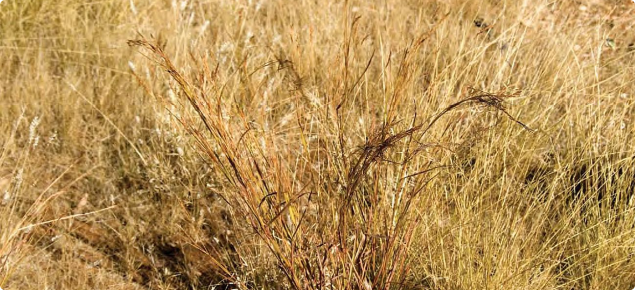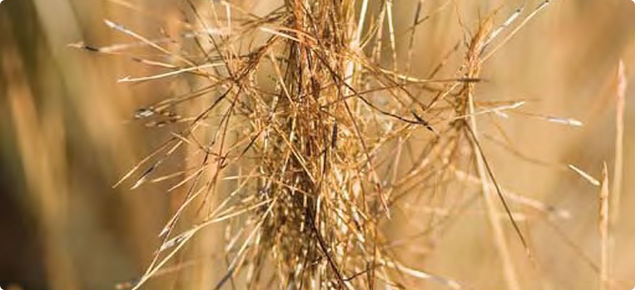Black speargrass pastures
These pastures are part of the Kimberley red soil group - not spinifex pastures, and black speargrass (Heteropogon contortus) is the identifier grass. Use the interactive key to pasture condition to help identify pasture type.
Pastoral value
Black speargrass can be heavily grazed when young, especially when regenerating after fire. However, mature black speargrass is not preferred by cattle and so the value of the pasture largely depends on the other species growing with it. When pasture condition declines and undesirable or unpalatable species become more dominant, the carrying capacity of black speargrass pasture is quite low.
It is possible that some black speargrass pastures have become established on previously degraded red-soil areas that used to carry more productive pasture types.
Occurrence
Black speargrass pastures occur on plains and lower hillslopes throughout the east and north Kimberley. They are found on a variety of sandy to loamy soils and usually occur as grassy, open eucalypt woodlands.
Pasture condition
Good: In good condition, these pastures are almost completely dominated by black speargrass. The plants are robust and, unless the pasture is regrowing after a fire, there is virtually no bare ground. Small amounts of other desirable perennial grasses, such as white grass and ribbon grass, may be present, but generally do not comprise more than 20% of the stand (Figure 1).

Fair: As pasture condition declines from good to fair, black speargrass remains dominant but its density is reduced, with gaps visible in the stand. Intermediate species, such as wire grass, and undesirable species, such as threeawns, become more prominent. Palatable perennial grasses, such as ribbon grass, are all but absent (Figure 2).

Poor: Poor condition is characterised by increasingly large areas with little or no perennial grass cover between the black speargrass plants. These areas may support annual grasses early in the season, but often become bare later in the year as the annual grasses are grazed, trampled or dry up and blow away.
While undesirable perennial grasses and a few scattered intermediate species may be present, black speargrass remains the dominant perennial grass (Figure 3).

Associated plants
| Common name (link to DPIRD species page) | Scientific name (link to FloraBase) | Life form |
| Desirable species | ||
| perennial grass | ||
| perennial grass | ||
| perennial grass | ||
| Intermediate species | ||
| Wire grass, northern Wanderrie grass | perennial grass | |
| Nineawns, bottlewashers, limestone grasses | Enneapogon spp. | annual or short-lived perennial grass |
| annual grass | ||
| Undesirable species | ||
| Unequal threeawn, feathertop threeawn | perennial grass | |
| Threeawn grasses | Aristida spp. | annual or perennial grasses |


